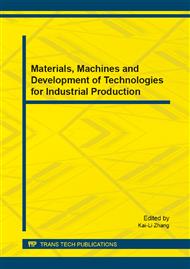[1]
M. Lu, X.J. Wu, X.F. Wei, Chemical degradation of polyacrylamide by advanced oxidation processes, Environ. Technol. 33 (2012) 1021-1028.
DOI: 10.1080/09593330.2011.606279
Google Scholar
[2]
G.B. Ortiz, O.M. Alfano, A.E. Cassano, 2-Chlorophenol degradation via photo Fenton reaction employing zero valent iron nanoparticles, J. Photochem. Photobiol., A. 233 (2012) 53-59.
DOI: 10.1016/j.jphotochem.2012.02.023
Google Scholar
[3]
B. Yuan, X. Li, K. Li, W. Chen, Degradation of dimethyl phthalate (DMP) in aqueous solution byUV/Si-FeOOH/H2O2, Colloids Surf., A. 379 (2011) 157-162.
DOI: 10.1016/j.colsurfa.2010.11.039
Google Scholar
[4]
B. Yu, W. Wang, Z. Cai, Application of sodium oxalate in the dyeing of cotton fabric with reactive red 3BS, J. Text. Inst. 105 (2014) 321-326.
DOI: 10.1080/00405000.2013.839354
Google Scholar
[5]
M. Vilve, S. Vilhunen, M. Vepsäläinen, et al, Degradation of 1, 2-dichloroethane from wash water of ion-exchange resin using Fenton's oxidation, Environ. Sci. Pollut. Res. Int. 17 (2010) 875-884.
DOI: 10.1007/s11356-009-0291-5
Google Scholar
[6]
F. Fu, L. Xie, B. Tang, et al, Application of a novel strategy-Advanced Fenton-chemical precipitation to the treatment of strong stability chelated heavy metal containing wastewater, Biochem. Eng. J. 189 (2012) 283-287.
DOI: 10.1016/j.cej.2012.02.073
Google Scholar
[7]
M.L. Rache, A.R. García, H.R. Zea, et al, Azo-dye orange II degradation by the heterogeneous Fenton-like process using a zeolite Y-Fe catalyst-Kinetics with a model based on the Fermi's equation, Appl. Catal., B. 146 (2014) 192-200.
DOI: 10.1016/j.apcatb.2013.04.028
Google Scholar
[8]
A.C. Pradhan, B. Nanda, K.M. Parida, et al, Quick photo-Fenton degradation of phenolic compounds by Cu/Al2O3-MCM-41 under visible light irradiation: small particle size, stabilization of copper, easy reducibility of Cu and visible light active material, Dalton Trans. 42 (2013).
DOI: 10.1039/c2dt32050a
Google Scholar
[9]
C. Jiang, Z. Xu, Q. Guo, et al, Degradation of bisphenol A in water by the heterogeneous photo-Fenton, Environ. Technol. 35 (2014) 966-972.
DOI: 10.1080/09593330.2013.857699
Google Scholar
[10]
Y. Ling, M. Long, P. Hu, et al, Magnetically separable core-shell structural γ-Fe2O3@Cu/Al-MCM-41 nanocomposite and its performance in heterogeneous Fenton catalysis, J. Hazard. Mater. 264 (2014) 195-202.
DOI: 10.1016/j.jhazmat.2013.11.008
Google Scholar
[11]
M.A. De León, M. Sergio, J. Bussi, et al, Application of a montmorillonite clay modified with iron in photo-Fenton process. Comparison with goethite and nZVI , Environ. Sci. Pollut. Res. Int. (2014) 1-6.
DOI: 10.1007/s11356-014-2681-6
Google Scholar
[12]
H. Bel Hadjltaief, P. Da Costa, P. Beaunier, et al, Fe-clay-plate as a heterogeneous catalyst in photo-Fenton oxidation of phenol as probe molecule for water treatment, Appl. Clay Sci. 91 (2014) 46-54.
DOI: 10.1016/j.clay.2014.01.020
Google Scholar
[13]
L. Sun, Y. Yao, L. Wang, et al, Efficient removal of dyes using activated carbon fibers coupled with 8-hydroxyquinoline ferric as a reusable Fenton-like catalyst, Biochem. Eng. J. 240 (2014) 413-419.
DOI: 10.1016/j.cej.2013.12.009
Google Scholar
[14]
Y.H. Chang, Y. F. Yao, H. Luo, et al, Magnetic Fe3O4-GO nanocomposites as highly efficient Fenton-like catalyst for the degradation of dyes, Int. J. Nanomanuf. 10 (2014) 132-141.
Google Scholar
[15]
J. Deng, X. Wen, Q. Wang, Solvothermal in situ synthesis of Fe3O4-multi-walled carbon nanotubes with enhanced heterogeneous Fenton-like activity, Mater. Res. Bull. 47 (2012) 3369-3376.
DOI: 10.1016/j.materresbull.2012.07.021
Google Scholar
[16]
X. Hu, B. Liu, Y. Deng, et al, Adsorption and heterogeneous Fenton degradation of 17α-methyltestosterone on nano Fe3O4/MWCNTs in aqueous solution, Appl. Catal., B. 107 (2011) 274-283.
DOI: 10.1016/j.apcatb.2011.07.025
Google Scholar
[17]
W.C. Hsu, C.H. Yang, W.T. Tsai, Catalytic effect of MWCNTs on the dehydrogenation behavior of LiAlH, Int. J. Hydrogen Energy. 39 (2014) 927-933.
DOI: 10.1016/j.ijhydene.2013.10.155
Google Scholar


